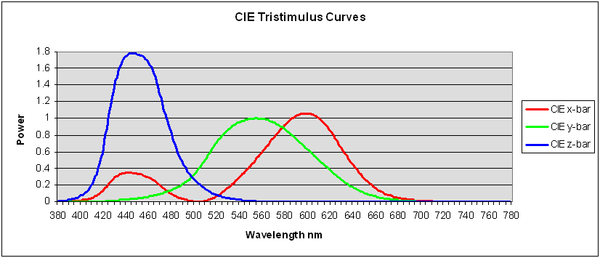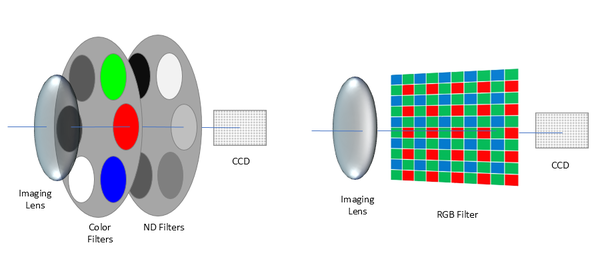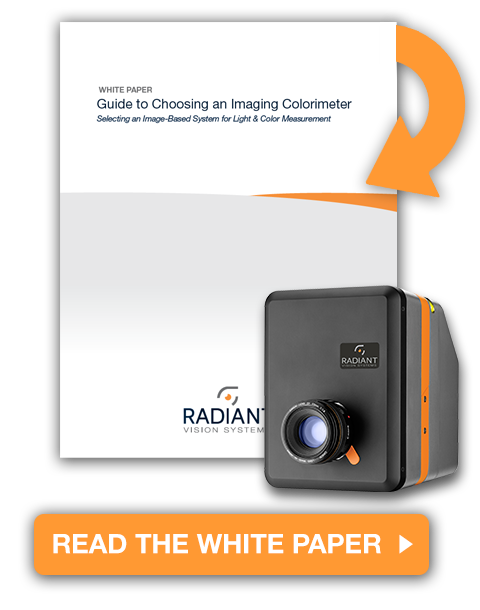Achieving the Most Accurate Color Measurement Using Imaging Systems
CCD (Charge Coupled Device) and CMOS (complementary metal-oxide semiconductor) sensors work by converting light into electrical current (electrons), allowing images to be recorded digitally, in pixels. (To learn about some of the notable differences between CCD and CMOS in greater detail, click here.) When configured effectively, imaging systems excel at measuring luminance and color uniformity, identifying defects (dead pixels, particles, and lines), measuring multiple spots (LED arrays), rapid collection of multiple data points, and providing the data for advanced analysis.
This blog post looks specifically at measuring color with imaging systems. Radiant’s ProMetric® I Imaging Colorimeters are built to take full advantage of high resolution, optical filter methods, and the capabilities of imaging to enable precision imaging for detailed analysis, combined with the most accurate color measurement correlated to human visual perception.
An image sensor itself is sensitive to electromagnetic radiation in the range from about 300nm to 1080 nm. Therefore, capturing color images requires: (1) filtering the incoming light so that only the desired wavelengths (colors) reach the sensor surface, and then (2) aggregating the component images into a complete color image. There are several ways to mechanically accomplish this, each of which basically involves capturing individual red (x-bar), green (y-bar), and blue (z-bar) filtered images. For color accuracy, the filters must deliver a very good match to CIE response curves, which replicate the human eye’s sensitivity to light. (For a detailed explanation of the spectral sensitivity (tristimulus) response curves, read this article published by IEEE.)
Replicating the human eye’s response is very important for color accuracy, since “accuracy” is subjective based on human visual perception. An image-based measurement system that is CIE-matched for colorimetric measurement provides the most relevant evaluation of color based on the human experience, ensuring optimal quality as perceived by users of the light-emitting device.

The CIE XYZ color space represents all colors visible to the human eye.
On-detector filters
One common approach to image-based color measurement is to place a rectangular array of red, green, and blue color filters directly onto the surface of the sensor pixels, in what is known as a Bayer pattern. This is very similar to the method used in consumer digital cameras. The advantages of this method are low cost, imaging speed, limited hardware, and no moving parts.
However, these advantages are outweighed by several disadvantages for most imaging colorimetry applications. First, because the Bayer-pattern color filters are spread across the senssor (using multiple sensor pixels for each filter), the number of pixels capturing information for each individual color is only a fraction of the total pixels on the sensor. This reduces the effective resolution of the image, making it more difficult to capture small details. In addition, color accuracy is compromised because the Bayer filter technology is not able to provide an accurate match to the CIE spectral response curves to replicate human vision.
Moving filter wheel
Another approach to image-based color measurement is to use a motorized filter wheel. By sequentially spinning the various color filters into place in front of the sensor at CIE-weighted exposures, the requisite series of component images can be captured to provide a complete color image. In this scheme, an electronic or mechanical shutter is necessary to block light from the detector between the exposures.
Use of a filter wheel can deliver color images with very high dynamic range, low noise, high spatial resolution, and high fill factor when coupled with high-performance sensors. This approach uses tristimulus filters for red, green, and blue (correlating to the three photopic response curves of the CIE color-matching functions), making it possible to achieve a very good match to CIE color-matching functions for color imaging weighted to human perception. Because light passes through each filter at various angles of incidence, it is also important that the filters have minimal change in performance over the range of incidence angles. For this reason, absorptive filters provide more accuracy than thin film filters.

CIE-matched tristimulus filter (left) and Bayer pattern RGB filter (right) configurations.
Using a filter wheel has several advantages over other color measurement methods. First, it is the most precise and stable filtering method available at reasonable cost. Second, the approach can be easily extended to use other specialized wavelength filters, such as NIR (near-infrared) filters. Realizing these advantages requires precise mechanical design and calibration, adding some complexity and cost to the imaging colorimeter. However, as with Radiant’s ProMetric I Imaging Colorimeter, these systems can be integrated as fully turnkey systems with electronic software control and touch panel HMI, simplifying application in both labs and production environments.
To learn more, read Radiant’s white paper “Guide to Choosing an Imaging Colorimeter” or contact us to discuss your color measurement application.

Join Mailing List
Stay up to date on our latest products, blog content, and events.
Join our Mailing List
